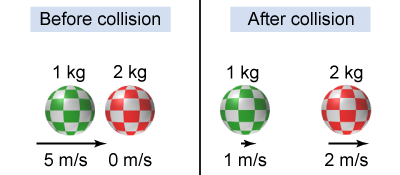- Jimi (80 kg) and Tony (100 kg) stand motionless on ice skates, facing each other at arm’s length on a smooth, frozen pond. Which of the following actions will give Tony the greatest speed?
- Tony pushes Jimi with 100 N of force for 0.1 s.
- Jimi pushes Tony with a force of 60 N for 0.2 s.
- Tony pushes Jimi with 200 N of force for 0.08 s.
- Jimi pushes Tony with a force of 250 N for 0.04 s.
- A 1,500 kg car sliding on frictionless ice at 15 m/s hits a stationary, 2,500 kg minivan. The two vehicles are locked together after impact on the ice. What is their speed after impact?
- 0 m/s
- 5.6 m/s
- 7.5 m/s
- 15 m/s
- A truck with a mass of 2,000 kg and moving at 15 m/s collides with a stationary passenger car of mass 1,000 kg. The two cars stick together after impact. Assuming that they are free to move afterward, what will the momentum of the truck+car object be?
- 2,000 kg m/s
- 3,000 kg m/s
- 15,000 kg m/s
- 30,000 kg m/s
- An 800 kg car with 200 kg of passengers and cargo is moving at 10 m/s. Suddenly, the driver applies the brakes and the car skids to a stop. What happens to the momentum that the car (and its contents) had before braking?
- It is transferred to the pavement (and the Earth).
- It is destroyed.
- It is transferred to the passengers and cargo.
- It is turned into sound.
- A spacewalking astronaut is stranded a few meters from the space-station door. His jet pack is broken, but he can take it off and toss it in order to propel himself toward the door. In what direction should he toss it?
- toward the door
- away from the door
- toward the Earth
- The answer cannot be determined from the information provided.
| | - Which of the following equipment is the best choice for investigating elastic or nearly elastic collisions?
- a marble launcher that causes two marbles to collide with each other
- two sliding carts on a frictionless track that stick together after impact
- ball of soft clay that flattens when it hits the ground
- crash test cars with front ends that crumple upon impact to absorb all the initial kinetic energy
- Two spring-loaded ballistic carts, one of 200 g and the other 800 g, are released and the lighter cart is observed to move at +1 m/s afterward. What is the velocity of the other cart?
- −0.25 m/s
- +0.25 m/s
- −4 m/s
- +4 m/s
- In an inelastic collision, what quantities are conserved?
- momentum only
- kinetic energy only
- momentum and kinetic energy
- neither momentum nor kinetic energy

- One sphere of mass 1 kg is moving at 5 m/s to the right until it smacks into a stationary, 2 kg sphere. After the collision, both spheres travel to the right: the 1 kg sphere at 1 m/s and the 2 kg sphere at 2 m/s. What kind of collision took place?
- an elastic collision
- an inelastic (but not perfectly inelastic) collision
- a perfectly inelastic collision
- The answer cannot be determined from the information provided.
- Two friends stand on rollerskates, facing each other within arm’s reach. Jimi pushes gently on his friend Tony’s upraised palms. What happens?
- Jimi remains motionless and Tony rolls backward.
- Jimi rolls backward and Tony remains motionless.
- Jimi rolls forward and Tony rolls backward.
- Jimi and Tony each roll backward.
|

